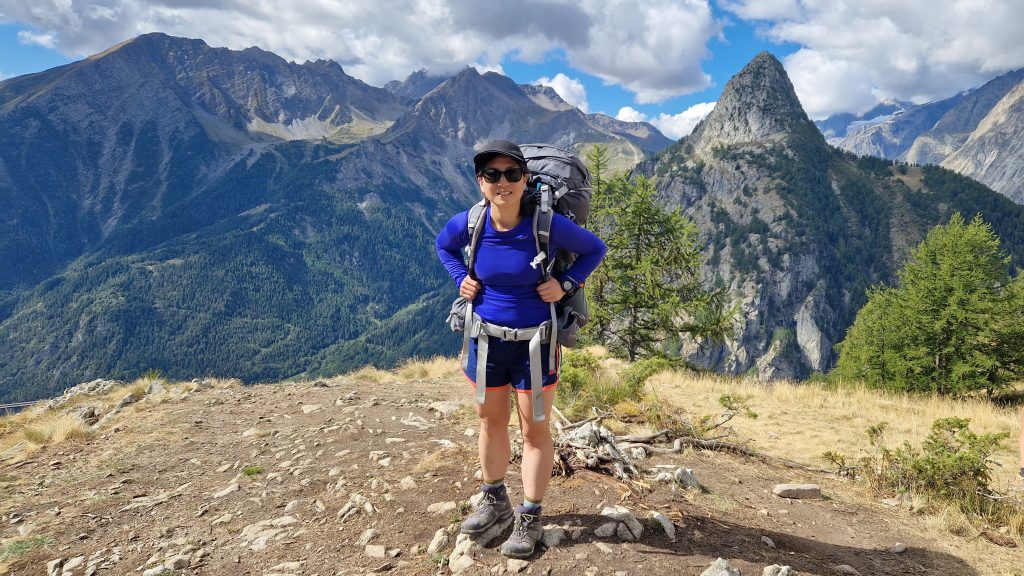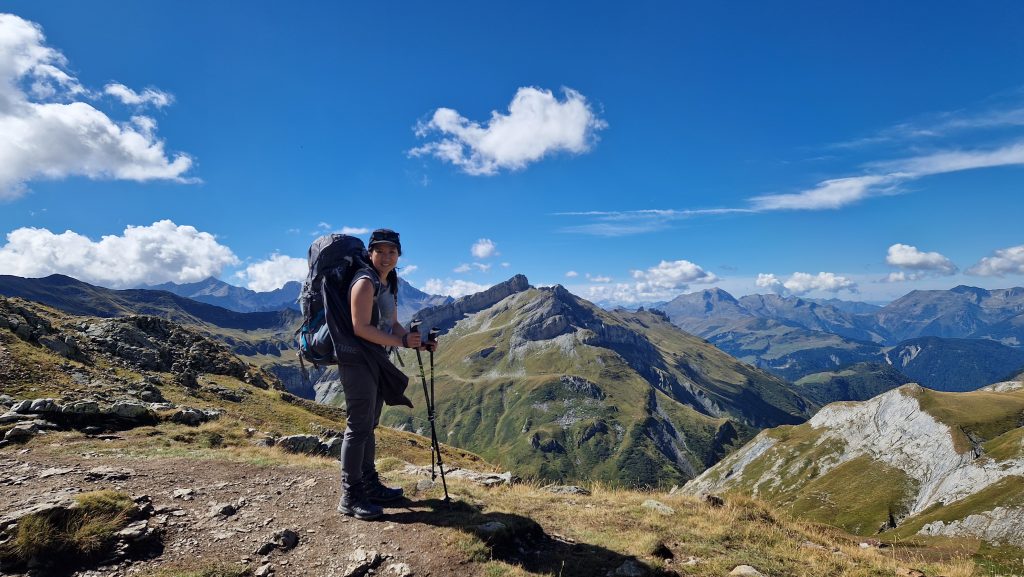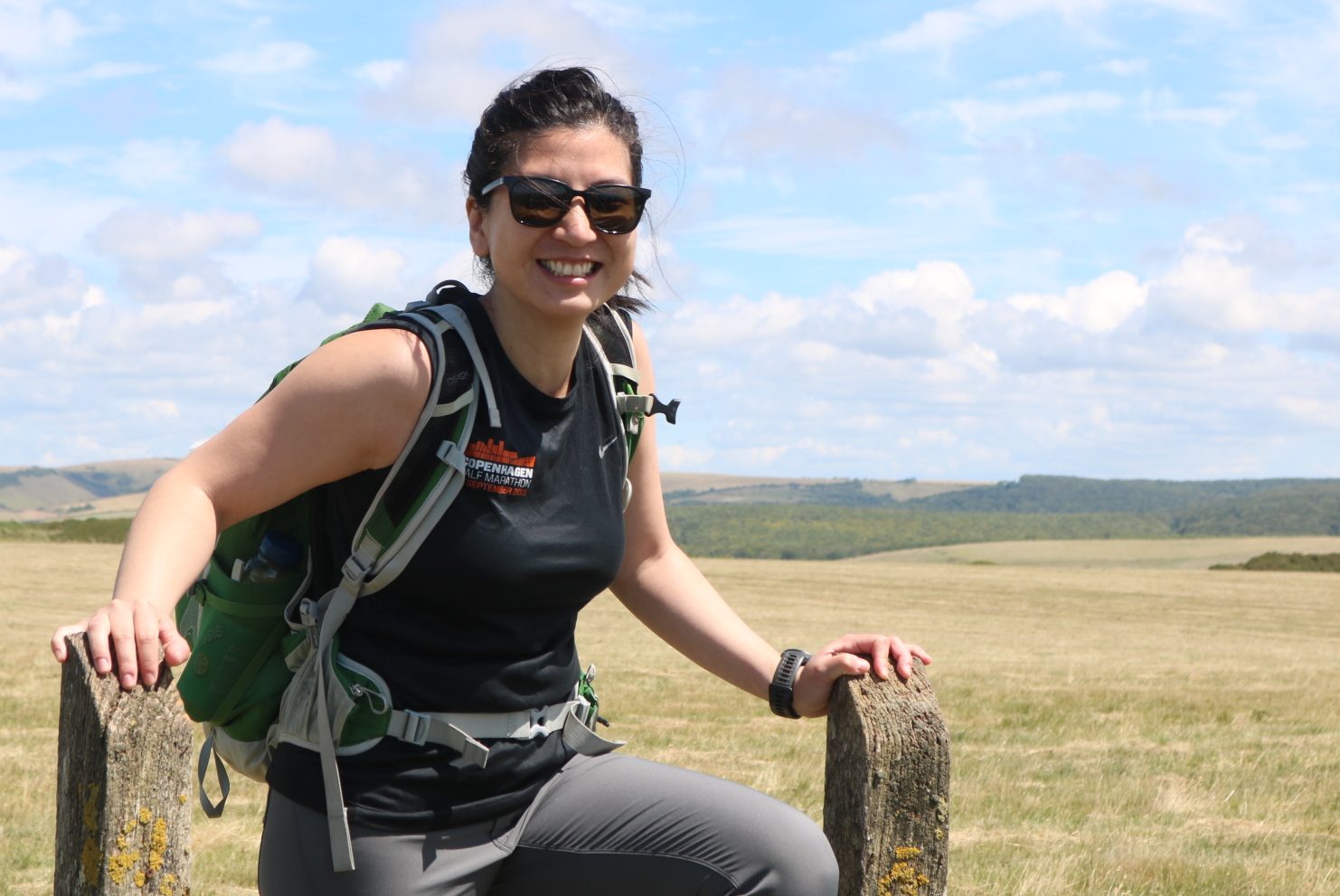From mapping out your route to sorting out logistics, brazen multi-day hiker and Slow Ways volunteer Ingrina Shieh shares her love for continuous hiking and her top tips for getting started!
The first walk I tried in the UK was sourced from a pocket-sized, no frills book titled The Best Walks in the Lake District, from which I chose the classic Langdale Pikes circular from New Dungeon Ghyll. Subsequent walks followed the same approach, and these guidebooks took me to stunning areas and summits throughout the UK and nurtured my love for walking.
For the most part, I opted for circular walks for practicality, beginning and finishing at the same point to get back to the parked car or the bus/train stop. These were certainly thrilling, but after years of walking in circles of different circumferences, one day I looked over at the fells just a half mile beyond and wondered, what if I didn’t have to turn back? What if… I could just keep going to that fell over there, and then the ones beyond that? Where would I end up?
What if… I could just keep going to that fell over there, and then the ones beyond that? Where would I end up?
The uncertainty of how far that trail could go was titillating. I went on to plan my first multi-day hike in Cornwall, following the Southwest Coastal Path from Penzance to Falmouth, 100 kms in 4 days. It was tiring. I packed far too much, it was hot, my shoulders ached in a way I’d never known.
And I loved it.
My body felt every sweatdrop of that achievement as much as it did the exhaustion. I’ve since done more multi-day walks, from established national trails like the West Highland Way to self-planned routes from London to Brighton. It is exhilarating to look at the map and see the distance I covered on foot each day. While tough, walking from point A to point B, day after day, has a beautiful simplicity. Get up, one foot after another to the next destination, repeat.
Of course, there are always parts that aren’t scenic, tricky to navigate, or simply unpleasant, but it all adds to the story of a journey from one place to another. Rather than speeding by on the road, walking in its slowness allows me to take in my surroundings in their totality, feeling and seeing the change of the landscapes, towns, and cities I cross. It also gives me space to reflect on our relationship with nature and consider our role in being in it and a part of it.
Slow Ways launched during the early days of my multi-day explorations. As someone who loves travelling on foot, the idea of walking from town to town (or nodes) across the UK sounded brilliant. I still love walking across the fells, but this new kind of network opened up more possibilities of discovering the country and travelling. I took on a challenge to walk from London to its closest national park, South Downs National Park, and created a waylist that would carry me around 120km over three days (which I’ve spoken to Slow Ways about here).
Having done that route, I would definitely recommend using Slow Ways to plan a multi-day walk, whether you’re trying your first one or have walked from Lands End to John O’Groats. Using the Waylist feature, I can connect different routes to save on my navigation apps that are a bit more off-the-beaten track than well-trodden national trails. I can keep the route private or make it public for others to use as well. And though I love walking national trails, I also love planning my own routes.

For seasoned walkers, Slow Ways offers a great, new way to visit different parts and paths of the UK and to encourage others to follow suit by leaving reviews and/or publishing your waylists.
For the newer walkers, because the routes connect towns and villages, there are several opportunities for stopping if needed (and if planned), as well as plenty of supplies and facilities along the way.
So if you’re thinking about trying out your first multi-day walk, read on for some of my tips!
(Disclaimer: I do not hold qualifications in mountain or low level walking, though I have taken a mountain leader training course. These are just things I personally found helpful for myself, but please do seek out professional guides and/or resources on how to stay safe, prepare for the elements, and kit recommendations.)
Do I really need to plan?
Long distance routes will take more planning than day walks, especially if you’ve not done it before. Also, if you are limited on time, planning is essential unless you can identify points where you can make early exits. If you have time to go as slowly or quickly as you’d like, you might not feel the need to plan a stringent schedule, but you’d still have to ensure that you are prepared in other ways – you have enough food, water, the right kit, etc.
Choose your route
The questions below might help you determine locations of origin and destination – the first step!
- – What area would you like to explore?
- – Would you like to do a low level walk in valleys or would you like to climb a few summits along the way?
- – How far would you like to walk? How many days can you walk the distance in?
- – How long do you think you can/would like to walk each day? Work out an average daily distance and break your route into stages. If it’s your first time, it could be wise to dial each day back a few kms. Bring a book or podcast to keep you occupied if you finish early. By all means, test your boundaries if you’d like, but remember that there is a big difference between doing two 30-km walks one week apart versus doing them over two consecutive days.
Tip #1: I like to think of little prompts that make a story. I chose London to Midhurst because I wanted to walk from London to its closest national park (South Downs National Park). I walked from London to Brighton on the basis that it was a common travel route by train and bike, so I wanted to try it on foot. Slow Ways is also working on a beast of a trail connecting the national parks to each other across the UK.
Tip #2: I always have a Plan B (sometimes a Plan C) and choose a backup destination in case I get tired or injured. Having picked up minor injuries from overuse, I’ve learned that ultimately listening to the body will help me continue walking in the long run.
Map your route
Assuming you’ve opted to map your own route rather than take on a signposted trail, let’s get mapping!
Here are some tools you can use:
- – Navigation apps like Ordnance Survey, AllTrails, Komoot, and Outdoor Active allow you to upload GPX files so you can track your progress and location on a map. Beware of where you might lose reception if you can’t use the map offline.
If you’re using Slow Ways, you can:
- – Go to the home page to see where routes connect your origin and destination
- – Create a new a Waylist (or two!)
- – Download the GPX file of each route and upload to a navigation app
- – Or try their new app on OS!
There are also plenty of route suggestions on other apps and websites like Ordnance Survey, AllTrails, Komoot, Walk Highlands, and the area websites themselves. Most of them also make GPX files available to download and use offline. Note: Some of the apps only allow offline use if you pay a subscription.
Tip: If you want to conserve battery, you can enable location services and go on flight mode. This should allow your app to continue tracking where you are on the map if you can use the app offline.
Logistics
If you’re like me, logistics are a huge deal, and here are some notes that might be useful:
- Travel: How will you get to/from the walk? A lot will depend on your mode of travel. I usually take public transport, so I aim to make the penultimate bus/train, which means that if any delays, cancellations, or walk disasters come up, I can still get the last service as a backup. And yes, I also have a backup to that backup – ensuring I’ve got enough means for a phone call and/or a taxi.
- Know how much daylight you’ve got: Night walking can be special, but only if you’re prepared! Keep an eye on the sunrise and sunset time and plan your distances accordingly.
- Accommodation: Budget, location, and how you get there, particularly from the destination of your walking route. I’ve been caught out before where I had to walk another few kms to the hotel/campsite because I’d booked it away from the town centre.
- Food: Will you need to pack or cook any food or will you stop by towns for food? Consider weight and what you can carry if you’re packing food. If you want to rely on shops/restaurants, it could be helpful to calculate estimated arrival times and whether snacks are needed in between destinations.
- Toilets: Try to find out where you’ll be able to use toilets for your own comfort. Slow Ways routes that have been surveyed include information on facilities found at the location.
- Kit: Ensure you’ve got the right clothes, footwear, waterproofs, equipment, and supplies. There are plenty of good articles out there on packing list suggestions. If you can, do invest in good socks and waterproofs!
- Compass and map: This is part of your kit, but it’s listed separately here to emphasise that these are really handy for when technology checks out on you.
- Walking poles: This is optional, but I wish I’d taken these up when I was younger. If you’re carrying heavy loads (like I do when I backpack) or if you’re doing a lot of descents, these will save your knees from bearing a lot of the impact. They’re also handy for fording rivers and going through bogs.

Training
Don’t be fooled that slow could mean easy! While walking is indeed much gentler than other sports, doing it day after day can take a toll. Training a bit can help make the journey a bit more comfortable and enjoyable.
A few quick tips:
- If you’ve not done a lot of long distance walking before, try increasing your distances slowly to avoid injury
- Break in the shoes you’re planning to use. Some walking boots require more use than others
- Try different thicknesses of socks to narrow down what you feel more comfortable in
- Do some walks on consecutive days so your feet and legs can get used to back-to-back walking
- Use your training walks to try different ways of fueling
- Training could help you figure out if you’re prone to blisters. In this case it might be helpful to pack some blister tape and use them before the blisters form.

Ingrina Shieh
Ingrina Shieh is a volunteer London National Park City Ranger and passionate active traveller who loves exploring places and connections on foot. Ingrina has walked in many different parts of the UK on established trails in between cities or towns. Her recent solo journey took her on 15 routes over three days from London to its closest national park, South Downs. She particularly loves multi-day hiking and camping and is now working towards a UK Mountain Leader Award.